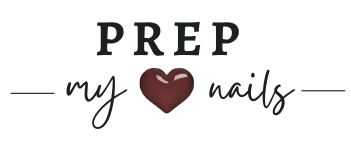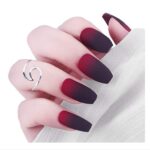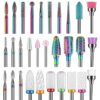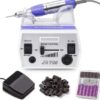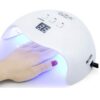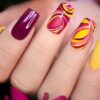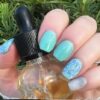Many individuals like getting an excellent manicure to have nice-looking nails to flaunt around. Nail extensions are a trendy nail style that allows you to express yourself by creating long, multicolored nails. Nail extensions are a component of Chinese culture’s old tradition of displaying long nails as a symbol of prestige.
The word “nail extension” refers to an additional artificial nail put on the existing nail to make it appear longer and more appealing while also adding attractiveness to the fingertips. Nail extensions come with Acrylic and Fiberglass for added toughness and longevity. There are a few popular nail extension choices on the market that you’ll want to consider. Read below to know more about the many varieties of nail extensions.
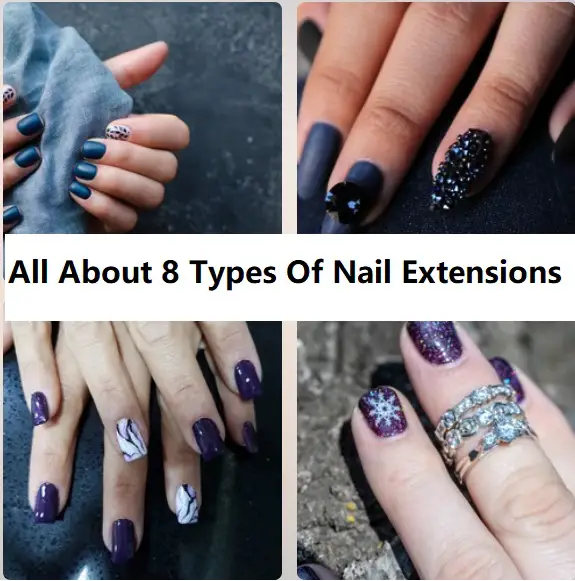
1. Acrylic Nail Extensions
Acrylic nail extensions are the most popular ones. They are strong, creative, and can be done on nails of any length. Even the short bitten nails can enjoy acrylic extension. Also, acrylic nails do not need UV light to dry. Air drying acrylic takes 10-15 minutes. However, they need constant upkeep like other extensions and can be very costly to maintain. In that case, an acrylic kit for beginners can give you beautiful nails at a very low cost.
This is how it should be done for a long-lasting extension.
Filing and buffing away the natural nail along the top edge, sides, and surface is the first step in applying artificial nails with extensions. After that, the nail tips must be bonded on. Acrylic nails comprise a liquid monomer and a powder polymer combination. Combining these two materials forms a thick coating that protects the nail while also allowing you to shape over it.
The longer the acrylic polish is exposed to the air, the harder it becomes; thus, you must apply it soon enough to avoid drying out. After the acrylics have been set out and distributed uniformly over the nail to create an excellent covering, they should be shaped and polished for a clean appearance.
2. Gel Nail Extensions
Gel nail extensions have become a popular choice among the many forms of nail extensions for various reasons. One of the most crucial things about gel nails is that they are more resilient and stay longer. The creation of gel nails involves a technique similar to that of acrylic nails. There are two methods for shaping the nails. The first method entails gluing plastic nail extensions to put the gel over the top.
The alternative approach is creating the nail extension with a paper shape. The bottom of the paper forms must be connected to the nail once you fold them appropriately. Apply the initial gel according to the paper form to make the tip. When your tips are ready, apply an even coat of gel, which may then be filed and cleaned before you begin applying your color gel polish. The gel technique gives you a more natural look. The extension is more flexible and thinner.
3. Acrygel
Acrygel is a relatively new product that is now fashionable. It combines the benefits of acrylic and gel nail extensions into a single product. You may create nail extensions, strengthen natural nails, and repair broken nails. It has a thick density and comes in a tube or pot.
There aren’t many brands that sell this product right now and those that don’t come in a wide range of colors. It implies that if the client wants a different color or pattern, they must use Gel Polish on top. You can use forms, tips, and dual forms to shape nail extensions.
When using dual forms, the substance is put within the form and then pushed against the natural nail. The shape is then removed when hardened with a UV/LED bulb. It’s a terrific technique to get a nail fast, but it’s pretty limited in terms of shape and structure. The substance is applied to the nail with a brush and dragged around until you get the desired shape when using tips or forms. Typically, one scoop is sufficient to construct the nail.
4. Express Nails
The quickest way to acquire nail extensions is with express nails. The gel is placed onto the nail from beneath the tip. A UV/LED lamp is used to treat it. It’s similar to how you’d apply a press on a false nail.
However, it is more durable because the gel is used instead of glue. Some express nail shapes, such as Apres, are more curved, resulting in an apex when applied. Apres Nails are only available as straightforward tips; if you want color on top, you’ll need a Gel Polish manicure.
5. BIAB ( Builder In A Bottle)
Hard Gel is a form of BIAB. It comes in a bottle, though, and has a thinner consistency. The nail technician must create an apex to ensure that the nail is formed correctly and does not break when creating a long nail. Because of its delicate nature, BIAB takes a long time to complete.
As a result, this product is usually used as a natural nail overlay to fix a broken nail, restore chipped corners, or apply for short nail extensions. It’s applied in tiny layers that are each cured with a UV/LED bulb. Temporary heat spikes may occur throughout the curing process.
6. Fiberglass
Hard Gel is used in conjunction with Fiberglass. It provides the first shape on which you apply the gel, and it comes in the form of strings. It helps make thin, long-lasting short-medium nail extensions. They generally have a natural appearance, and pinching a C curve is simple.
This approach has been around for a long time, but it is just now gaining popularity. It’s most commonly used to make square nails.
7. Silk Wrap
If you’ve ever heard of the ‘teabag’ method of repairing a damaged nail, silk is comparable to Fiberglass. You can use it to give natural nails length or strengthen them.
The silk is attached to the nail with resin, then sprayed to activate it. To offer further support, a hard gel is put on top. In the 1980s, this was a standard procedure for nail extensions. However, only a few salons presently provide this service.
8. Powder Dip
Dip Powder Nails is a coating for short extensions applied with a brush. Because it’s challenging to create an apex and maintain proper nail structure, it’s better to use it as a natural nail overlay rather than nail extensions. It’s a three-part method that includes powder, resin, and activator.
The powders come in various colors, allowing you to create a stunning manicure without the need for Gel Polish or Nail Varnish. Designs, on the other hand, are impossible to achieve. The most you can do is create a color gradient. If you want to add a gel polish pattern on the top, your nails may appear thick.
Conclusion
These were the most common forms of nail extensions. However, how can you know which one to put on your nails? Every musician has a taste in music—Opt-in for the extensions you can master to obtain the most excellent service. If you enjoy intricate nail art and exquisite paints, the extensions beneath the design are unimportant.
Some people’s nails are better at holding Acrylic, while others have issues with it and prefer alternative ways. Experiment with different systems until you discover one that works for you.
More Articles On Nails Care:
- How To Use A Builder Gel On Natural Nails?
- How Much Is A Pedicure? – Complete Price Breakdown
- Best Nail Extensions For Short Bitten Nails
- How To Tell The Nail Tech What You Want?
- Does Kerasal Work?- Kerasal Nail Treatment Review
- What Is Monomer For Nails?
- Can You Use Any Nail Polish For Stamping?
- Can I Paint My Nails With Stamping Polish?
- What Kind Of Manicure Lasts The Longest?
- Can You Get Gel Nails Done On Short/Bitten Nails?
- How to Shape Coffin Nails in a Hurry?
